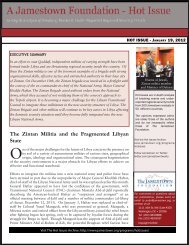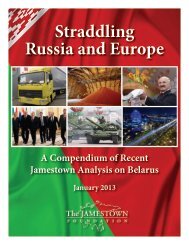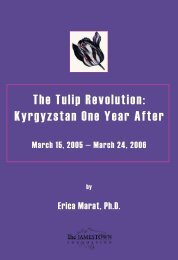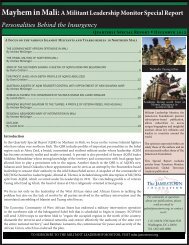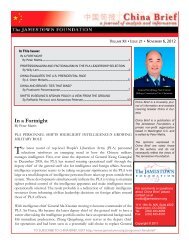By Brian Glyn Williams - The Jamestown Foundation
By Brian Glyn Williams - The Jamestown Foundation
By Brian Glyn Williams - The Jamestown Foundation
Create successful ePaper yourself
Turn your PDF publications into a flip-book with our unique Google optimized e-Paper software.
Ottoman frontier raiders such as the Mikhal-oghlu and the previously mentioned Mallach-oghlu. Halil<br />
Inalcik claims that the organization of these great ghazi dynasties was weakened in the sixteenth century<br />
and that the Crimean Tatars gradually replaced these families as the main Ottoman raiding force. 114<br />
Terminology aside, the Tatars were so successful in the role of akinji, or sackmen as the Germans knew them,<br />
that their service in other capacities on this front have been overlooked. An analysis of their contributions<br />
against the Habsburgs will show that the Crimean Tatars served the Ottomans as more than just raiders in<br />
their struggles with Emperor.<br />
Suleiman the Magnificent was the first Sultan to fully utilize the Tatars on the battlefields on the Ottomans ’<br />
western frontier. From his time on, the Tatars were utilized almost continuously in the Habsburg wars.<br />
<strong>The</strong>se wars, fought mainly for control of Hungary, went on intermittently for around two hundred years,<br />
during which time Pitcher claims the Tatars made seventeen contributions. Strangely enough this author fails<br />
to mention Tatar assistance in either of the famous Ottoman attacks on Vienna. 115<br />
In his bibliography of Suleiman, Harold Lamb makes several references to the Sultan's lavish use of the Tatars in<br />
both the 1529 and 1532 invasions of Austria. In his historic siege of Vienna, Suleiman's akinjis wreaked<br />
considerable damage on the Austrian countryside while his main force pounded away at the walls of the<br />
Austrian capital. Although Suleiman's diary does expressly say that the Sultan had forbidden the akinji<br />
to ravage the countryside, he does not seem to have enforced this command. 116<br />
It was not in the unsuccessful siege of Vienna that the Tatars were able to render their greatest services to<br />
Suleiman, but in the great raid of 1532. This campaign, which confused many Austrians in the sixteenth<br />
century and is still not fully understood today, gave the Crimean Tatars an opportunity to use their talents to<br />
the fullest. Suleiman began the campaign by besieging the Austrian town of Guns in an attempt to bring<br />
Archduke Ferdinand's forces out into the field of battle. When the Austrians prudently remained in Vienna, the<br />
Tatars were let loose on Austria in a massive raid that reached far into Habsburg lands.<br />
In his bibliography of Suleiman, Lamb gives a vivid description of the confusion caused by these raiders<br />
in the Austrian camp.<br />
<strong>The</strong>y never saw Suleiman, or his main army. <strong>The</strong>y heard tidings enough of the Turks. In<br />
the mountains south of them, towns fell before Turkish assaults; refugees began to come<br />
in from further west. <strong>The</strong> Turks were seen where no one expected them to be, between<br />
Vienna and Europe proper. Other, terrible horsemen who were not Turks drove through<br />
the upland valleys, turning to sweep through undefended villages, bridging rivers, or<br />
swimming them. <strong>The</strong>se mysterious riders proved to be the Tatars from Asia. <strong>The</strong> flying<br />
columns were seen at Steyr and along the Enns a hundred miles west of Vienna. 117<br />
<strong>The</strong> Tatars acted with relative impunity against a country that was not experienced, like Poland or Russia, in<br />
dealing with a steppe foe. <strong>The</strong> Austrians' differing views on the use of cavalry may have hindered their<br />
defensive efforts. In the West cavalry units were usually made up of heavily armed curaissers with light<br />
cavalry being used mainly for communication and reconnaissance. 118 <strong>The</strong> heavy Austrian curaissers<br />
were often unable to come to grips with the highly mobile light Tatar raiders.<br />
<strong>The</strong> Austrians did have the terrain on their side and, on several occasions, Habsburg forces were able to<br />
block off valleys and annihilate Tatar raiding parties. This, however, proved to be the exception rather than<br />
the rule. In the campaign of 1532, one historian estimates that as much as two thirds of the inhabitants of<br />
30






